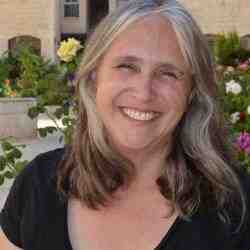Introduction
Shona McDonald is addressing the challenges of children with mobile disabilities who live in peri-urban and rural areas of South Africa with an approach that puts postural education on the agenda of community-based clinical services, along with a range of tailor-made mobility products that can be assembled and maintained even in conditions with limited resources.
The New Idea
Without the right type of wheelchair, children with disabilities can develop serious secondary health complications, and are at risk of becoming socially isolated. Shona realized early on that existing wheelchairs were not adaptable to the evolving needs of disabled children, and could lead to problems in physical development. This is especially true for those children in rural and peri-urban areas with limited access to quality wheelchairs appropriate for rugged terrain. Additionally, the likelihood of improved mobility over time is significantly reduced when mobility devices and clinical services for disabled children are designed without postural education in mind.
In order to address these challenges, Shona designs, manufactures, and distributes mobility and body support devices that improve the posture and mobility of children with disabilities. Shona sees these new wheelchairs as more than just a means of locomotion but as an opportunity to foster postural education for disabled children. Shona’s products are tailored to each child’s postural needs, can be easily maintained, and are modifiable for rural environments. These devices specifically consider the Southern African environment; for if they cannot be used to travel on the harsh and abrasive terrain, they are ineffective to the user and deny disabled children their independence. In this way, Shona’s designs are more progressive than most standard fold-up models that are donated by international organizations and commonly found in the region. Shona also uses existing health structures in rural areas to educate caregivers, the community, parents and the disabled in postural education techniques and mobility device usage and maintenance. The devices are manufactured and sold through Shonaquip (a for-profit organization) and distributed free of charge to communities in need through Uhambo Foundation (a citizen organization (CO) that also drives policy change and advocates for a more inclusive society).
To date, Shona’s organization has provided over 69,000 wheelchairs and seating support devices. For every child with a disability an average of another five to seven people are affected. Shona’s work has impacted more than 450,000 people including the seating and caregiver training programs, Shona plans to scale up production in order to double her impact over the next five years. She has also developed special toolkits and training sessions for people who cannot afford new wheelchairs (or do not have access to free wheelchairs) so that they can refurbish and adjust their old devices to meet their needs. Shona is working with the World Health Organization (WHO), to change their policies related to wheelchair and mobility equipment provision to populations in need all over the world.
The Problem
Based on WHO calculations, South Africa is home to more than one million people in need of wheelchairs. More than two-thirds of these people will need some adaptation and postural support products and services in order to prevent the development of further secondary health complications. More than 80 percent of those who need a wheelchair do not have one and the majority of these people cannot use the standard European model of a folding frame wheelchair. Donor organizations from developed countries have provided services and support to the disabled based on a charitable giving model for decades. Most donated chairs are modeled on the cheapest possible “one size fits all” design of U.S. or British hospital folding wheelchairs. Often, they are makeshift designs made of inappropriate materials such as plastic, wood, and bamboo. The problem with these well-intentioned donations is that they are not built and fitted for the individual patient and, thus, will only perpetuate serious medical issues and cause secondary health complications.
Children with mobile disabilities suffer from an unstable pelvis and trunk, which restricts the movement of their upper limbs and inhabits the development of fine motor skills. Without rectification, this accelerates the development of abnormal muscle tone and reflexes in the body, thereby decreasing the possibility of the child ever having normal movements. Thus, the child never gains functional independence and cannot participate in activities of daily living, school and leisure. Deformities can be limited, if not avoided altogether, with the use of good postural seating. Without good postural seating, however, tissue trauma (sores) develops from the unevenly distributed pressure of the body’s weight and results in increased fatigue for the child. More distressingly, the child has no control over the movements of his/her head, which is essential for orientation, socialization, and for the child to develop cognitive and communication skills. Without postural support, the child’s mental performance decreases and this gradually isolates him/her from his/her surroundings. Eventually, the body’s increasing deformity will have adverse effects on the child’s ability to eat and drink, as well as his/her respiratory and digestive functions.
The inhospitable terrain of peri-urban and rural communities makes the use of standard wheelchairs difficult. Without well-fitting and safe assistive devices that can be pushed on the unpaved and sandy ground in rural areas, people with disabilities are limited in their ability to access distant support services, education, employment, and even social contact. The shortage of appropriate wheelchairs has unnecessary, costly, and devastating social outcomes for the wheelchair users and their families. Thus, it is broadly acknowledged that having a mobility disability leads to worsening social and economic well-being and poverty, and that a child with a disability has fewer opportunities and adversely affects the family’s future.
Without access to the appropriate mobility and assistive devices, disabled children are less likely to attend school, engage in social interaction, or find employment later. Those that are born into poor rural families have an even smaller chance of improving their socioeconomic circumstances. If these issues are not addressed, disabled children will continue to be undervalued, and perceived as a source of shame and a burden to their families.
The Strategy
Shona’s work is carried out through two connected organizations: Shonaquip and Uhambo, the Shonaquip Foundation. Shonaquip is a for-profit venture that develops and manufactures these devices, and provides accompanying training on their use and other postural education techniques. This for-profit structure reduces the dependence on philanthropic and government funds, and frees Shona to invest in research and development so that she can rapidly increase her range of products as she designs new devices to meet the different needs of disabled children. Uhambo is a CO that produces and distributes these devices to those in need, and advocates for a more inclusive society. Profits from Shonaquip are reinvested in research and development of new devices and help fund Uhambo’s activities. Together these organizations work toward improving the quality of life of people with severe disabilities, especially for those in impoverished communities.
The primary focus of Shona’s work is to design, produce and distribute well-built wheelchairs and body support devices that are suitable for the Southern African terrain and that reduce the development of secondary health complications in disabled children. She does this by providing appropriate assistive devices, together with training on how to use them, to provide a 24-hour postural management solution for people with limited resources. All devices are made in close collaboration with users and are motivated by the needs of both the wheelchair user and the parents that care for them. The design is often developed for one specific user and then, once proven to be successful, is reproduced for more people. Feedback and physical trials of devices are a primary activity and ongoing evaluation is of significant importance. Shona invests in ongoing research and development of solutions for specific medical conditions, disability issues, mobility products and services—with the aim of having a positive impact on access to appropriate assistive devices and on national and global policies for people with mobility disabilities.
Another core component of Shonaquip and Uhambo’s work is the empowerment of wheelchair users, their families, and their service providers with the clinical skills, services, information, and training they need. As a part of this work, communities are offered support, training, and repair services in conjunction with the assistive devices. Shona is also working on the provision of clinical services to government agencies, COs, and the private sector, with particularly strong collaboration with government (through public-private partnerships) at the local and national level. Shona understands that close communication with local health education departments (about how to support and build their service capacity) is the most cost-effective way to build a delivery network. Through this collaboration, she has been able to build sustainable support structures; and has boosted the government’s efforts to incorporate the needs of disabled children into policy and implement these policies on the ground. In addition, her partnership with South Africa’s Department of Health has covered her production costs and subsidized community outreach clinic services; and, thus, contributed to her organization’s sustainability for many years. Private medical insurance and community projects funded by local businesses have provided additional income.
With this strategy in place, the functional abilities of wheelchair users in Southern Africa has not only stabilized, but also dramatically improved. This has had significant positive impact on the user’s quality of life. The additional advantages of improving access to these devices and removing barriers to services have resulted in a reduction in the long-term costs to national health budgets. To date, Shonaquip and Uhambo have provided over 69,000 wheelchairs and seating support devices, impacting over 450,000 (users and families), not including the seating and caregiving training programs.
Shona is working to reach 25 percent of the potential need in Southern Africa (250,000 people) and is focusing on job creation and improved quality of life for people with disabilities. She is looking to create 300 jobs over the next five years. Shona is also expanding geographically and is setting up full assembly and wheelchair seating service hubs in four neighboring countries, starting in Zimbabwe. The work of Shonaquip and Uhambo is monitored and evaluated for impact, and to publish data that supports clinical work, advocacy, education, and outreach training programs across Southern Africa. Shona will continue to develop training and support services in line with WHO guidelines and to seek change for children with disabilities at a global level.
The Person
As a young mother interested in sculpture and engaged in community service work, Shona’s life path took a dramatic turn with the birth of her second daughter, Shelly. Born with cerebral palsy, disabled, unable to speak and almost totally deaf, doctors and therapists advised Shona to put her daughter in a home and have another baby. Shocked and dismayed, Shona was determined to start building a positive future for Shelly. Shona was living in South Africa at the height of the anti-apartheid movement, which had resulted in extensive boycotts and trade sanctions that froze the country’s access to imported goods, including devices and parts of devices for people with disabilities. The upside of this situation was that Shona was forced to think of innovative ways to solve Shelly’s mobility challenges.
When Shelly was 18-months-old and getting too heavy to carry, Shona saw pictures in a Swedish magazine of an electric wheelchair with seating that can be tailored to an individual and made contact with the biomedical engineering department at the University of Cape Town to help her build a similar wheelchair. This led to the first South African battery-powered buggy, and provided the foundation for establishing Shonaquip in 1992. The buggy gave Shelly great freedom and enabled her to attend a local preschool, where, with all the stimulation she received, she progressed rapidly on to primary and then high school.
Through her continued work with the disabled in her community, Shona met many other parents of children with disabilities, who together with their therapists persuaded her to design and manufacture special devices for them. Unsustainable in the long-run, Shona turned Shonaquip into a social business, operating with sales of services and products. She also founded Uhambo Foundation, which operates on 100 percent of the profits from Shonaquip. Shona has won recognition for her work from several organizations, including a Schwab Foundation for Social Entrepreneurship Fellowship and the World Economic Forum Social Entrepreneur Award.
It is now Shona’s dream to see her devices used by children across Africa, and in countries such as Turkey, Chile, and the Philippines.




